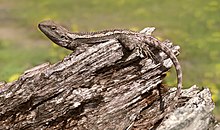Jacky dragon
| Jacky dragon | |
|---|---|

| |
| Scientific classification | |
| Domain: | Eukaryota |
| Kingdom: | Animalia |
| Phylum: | Chordata |
| Class: | Reptilia |
| Order: | Squamata |
| Suborder: | Iguania |
| Family: | Agamidae |
| Genus: | Amphibolurus |
| Species: | A. muricatus
|
| Binomial name | |
| Amphibolurus muricatus | |
The jacky dragon (Amphibolurus muricatus) is a type of
The
Taxonomy
The jacky dragon
Morphology

The jacky dragon is pale grey to dark brown in colour, with dark patches along the middle of the back. The dark patches are interrupted by pale blotches that often blend together to form a continuous stripe from above the arm to the groin.[4] A dark brown bar is present between the eye and the ear, but no dark stripe is present between the nostril and the eye, as in many other dragons. The lips and lower jaw tend to be of a lighter colour than the rest of the head. Jacky dragons are also characterised by a bright yellow lining in their mouths.[7] Specimens have been seen with orange-red corners on the inside of their mouths, which may have given rise to the common name of blood-sucker.
The jacky dragon is more readily distinguishable by its five crests: a
Reproduction and life cycle
The sex of the hatchlings is determined by the temperature of the nest, a process known as temperature-dependent sex determination (TSD). The hatchlings are females in low- and high-temperature environments and males in medium-temperature environments. This causes young dragons from clutches laid earlier in the season to be predominately male.
The jacky dragon reaches sexual maturity rapidly. Females can lay clutches within one year of hatching. The average lifespan of the jacky dragon is four years, which is significantly shorter than most lizards.[10]
Ecology
Distribution
Jacky dragons are found along the southeastern coast of Australia. They have been found as far north as central
Habitat
The jacky dragon is usually found in dry sclerophyll forests and woodlands. They are present in the eastern highlands, but not in alpine areas. They are semiarboreal, and individuals are often seen perching on fallen or standing timber.[7]
Predators and prey
Predators of young jacky dragons are numerous, and include small mammals, such as feral cats or rats, and other reptiles. Adults face aerial predation from birds such as kookaburras, ravens, black-shouldered kites, and Nankeen kestrels.[4] The dragons use visual cues such as the changing area over time, edge length, shape, and orientation in the recognition of aerial predators.[11]
Behaviour
Jacky dragons are very swift runners and, like many other dragons (Agamidae), will sometimes run in an almost upright position on their hind legs when pursued. In cool, wet weather, they bury themselves in the sand or shelter under a bush. They rarely enter the water, but do have the ability to swim.[3] In a fight, opponents circle each other in an upright position with their bodies laterally compressed so as to enlarge their appearance. They tend to direct their attacks towards the tails of their opponents. Various territorial displays include tail-waving, raising or lowering their bodies, head-bobbing, arm-waving, and darkening their colour.[8]
Jacky dragons have many different displays, or series of movements, that are used as communication between
Conservation status
The jacky dragon is not in danger of
References
- . Retrieved 20 November 2021.
- ^ "Species Amphibolurus muricatus (White, 1790)". Australian Faunal Directory. Department of the Environment, Water, Heritage and the Arts. 9 October 2008.
- ^ a b c d e f McPhee, David R. (1959). Some Common Snakes and Lizards of Australia. Sydney: Jacaranda Pocket Guides.
- ^ ISBN 0-7301-0088-X.
- ^ White, John (1790), Journal of a voyage to New South Wales with sixty-five plates of non-descript animals, birds, lizards, serpents, curious cones of trees and other natural productions, London: J. Debrett, also at Project Gutenberg Australia
- ^ ISBN 0-00-211420-8.
- ^ ISBN 978-0-691-11728-7.
- ^ ISBN 0-7322-0011-3.
- PMID 17645024.
- ^ S2CID 967516.
- S2CID 53162134.
- S2CID 16142779.
- S2CID 24090113.

